
JAMAICA Estates, built on the northern edge of the former Town of Jamaica in the 1905-1907 period, occupies about 500 acres between Home Lawn Street, Hillside Avenue, 188th Street and Union Turnpike. In the 1930s, it was neatly cut into two sections by the construction of the Grand Central Parkway right through it. When construction, consisting initially of Tudor-style homes on large plots (as large as 60’x105′), began Jamaica Estates was surrounded by open farms and fields, dotted by small towns and connected by wagon and farm-to-market roads, many of which developed into the pedal-to-the-metal boulevards we know today.
The project was conceived by former NYS lieutenant governor Timothy Woodruff and railroad builder Michael Degnon, who, among many other projects, constructed the Steinway Tunnels which today connect the #7 train with Manhattan and Queens. In Forgotten NY, Degnon is a familiar figure, mentioned on FNY’s Queens railroad spurs page. Degnon is in repose at Calvary Cemetery.
Degnon’s estate between Midland Parkway and Edgerton Boulevard at Wexford Terrace was acquired in 1923 by the Passionists, a Roman Catholic religious institute founded in 1725, to build a large retreat house; retreats are periods of religious study and reflection. “The Passionists serve as preachers, retreat givers, pastors, educators and in many other ministries in the Church.” [The Passionists]. Degnon’s estate house stood until 1950 when it was demolished when the retreat house was expanded. The property also includes a parish church attended by area residents.
Degnon, a devout Catholic himself, constructed Jamaica Estates’ sewer and utilities systems and laid out its street pattern.
179th Street is among the blandest, most uninteresting stations in the system from a design standpoint. Endless corridors of wall and walkway titles. The lengthy corridor, which connects the concourse with the Midland Parkway exit, is typical of IND design which extended from 1932 to 1950, when this station was built.
One of the only hints of decor at this station are interlocking bands of orange and blue (New York Mets colors?) on the tiled walls. As archived photos in NYC Subways show, there used to be a “regular” purple color band with a black border, typical of IND design. The new color bands were added during a 1990s renovation.
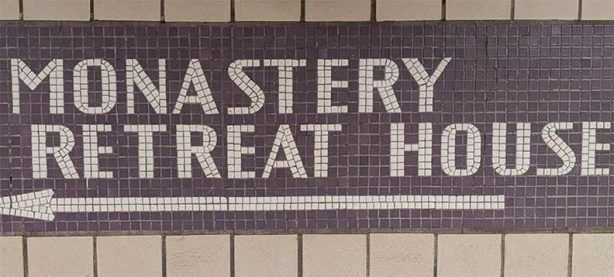
In a station of otherwise little interesting detail, one of the station concourse exits has this tiled sign pointing to the “Monastery Retreat House,” rendered in the original purple color of the original station trim when built in 1950. That makes it the last IND station built according to its original design specifications by a team headed by Squire Vickers in the 1930s.
“Monastery” photos: Mike Frandy
Check out the ForgottenBook, take a look at the gift shop. As always, “comment…as you see fit.” I earn a small payment when you click on any ad on the site.
7/12/25

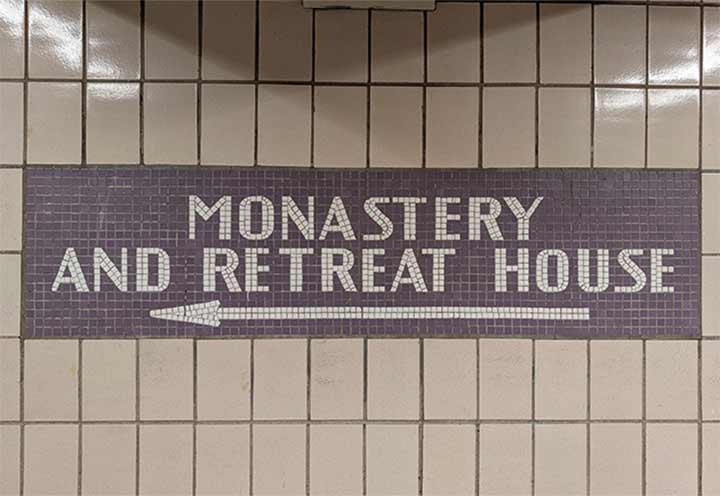
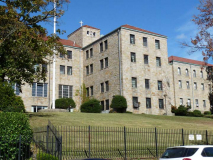
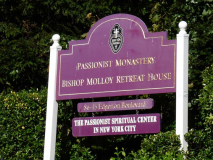
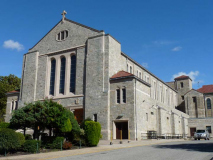
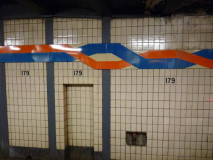
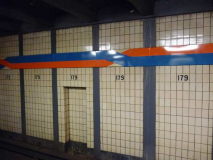
7 comments
As far as I know this is the only non-college religious institution that’s on station signage.
Two mosaic signs pointing to churches, at Pacific and Court Sts. The one at Pacific was torn down in 2016
Weren’t those “endless corridors” traversed by the young boy Donald Trump on his subway ride to the Kew Forest school?
179th St. is a very busy station because it is a key transfer point between the F train and 14 bus routes that stop there, including eight routes that serve adjoining Queens neighborhoods and six routes that extend into Nassau County.
I humbly submit that the blue and orange colors are not highlighting the Mets, per se, but are the official colors of New York City. Prominently displayed in our tri-color NYC flag, they are a direct representation of the Dutch flag of 1625 when New Amsterdam was founded. These colors are also used for our own “Metropolitans” baseball team. They have been previously used on the NYCHA housing signs, NYS landmark plaques and even NY State Police vehicles, distastefully referred to as “Sunoco’s” by upstaters in the 1960s and 1970s.
My grandfather, a New York City cop, attended a men’s First Saturday service at the monastery there in the 1950s and 60s. He helped build an outdoor altar also. The orange specifically is from William III, also known as William of Orange, the successor of James II.
and dont forget, Jamaica Estates is also the hometown of our illustrious
president,Donald John Trump